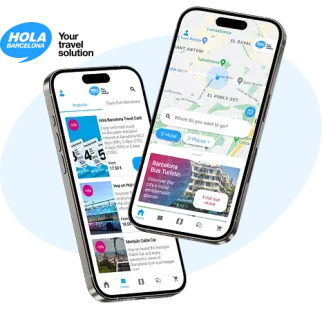Jewish Quarter
The medieval Jewish quarter with Spain's oldest synagogue
El Call de Barcelona is the sector of the current Gothic Quarter that was once Barcelona's Jewish neighborhood. This medieval district is home to one of the oldest synagogues in Europe, which has been restored and opened to the public.
Getting lost in the narrow streets of El Call is a must during your visit to the city.

Barcelona Bus Turístic, on the Hola Barcelona app
Your app for visiting the city with the Barcelona Bus Turístic: routes, stops and the most iconic places. A comfortable way to carry your tickets too!
El Call: Dive into the neighborhood that holds Barcelona’s most hidden secrets
From the 9th to the 14th century, Barcelona had a significant Jewish community, estimated at around 4,000 people. Two neighborhoods of narrow streets, called "call," emerged around them, derived from the Hebrew word "Kahal," meaning community or congregation.
El Call was one of the city’s medieval cultural hubs, housing two synagogues. One of them, the Sinagoga Major, dates back to the 6th century and is one of the oldest in Europe.
El Call de Barcelona once contained schools, bathhouses, and hospitals, though today only a few houses remain. The neighborhood was enclosed by two walls and situated along the boundaries of the old Roman layout. However, Jews were not confined within these walls—they had homes and workshops outside of them. By the early 13th century, the population had grown so much that the Call Menor was established, though virtually no traces of it remain.
El Call Major is home to the Sinagoga Major, also known as the Synagogue of Salomó ben Adret, a leading figure of Catalan Judaism in the 13th century, rabbi of Barcelona, and banker to kings such as James I. It was the center of Jewish life in the city until attacks against the community began, the most severe of which occurred in 1391 and resulted in the deaths of 300 Jews. In the following years, synagogues and Jewish cemeteries were abolished, and Jews were forced to convert to Christianity.
Today, the Barcelona History Museum includes a section, MUHBA El Call, located in the heart of the old Call district, where Jucef Bonhiac, a veil weaver, had his home. This section of the museum chronicles the history of Jews in Barcelona and their cultural legacy.
How to get to El Call?
From the Gothic Quarter stop on the Red Route of the Barcelona Bus Turístic, you can explore the medieval Jewish quarter of Barcelona.
For the curious ones
- On Carrer de Marlet, at the very center of El Call, there is a 9th-century Jewish tombstone. It was discovered among ruins when a house was built in 1820, and the inscription has a translation from that time.
- As you walk through El Call, look closely at the doorways on streets such as Arc de Sant Ramon del Call, where you can still see the holes where Jews affixed the "mezuzah," a parchment scroll containing two verses from the Torah that is placed at the entrance of a home.
- Following the expulsion of Jews ordered by the Catholic Monarchs in 1492, the neighborhood began to decline, and buildings were repurposed—the Sinagoga Major became a dye house, and the smaller synagogue was converted into a Trinitarian convent, of which only the church on Carrer Ferran, the Parish of Saint Jaume, remains today.












